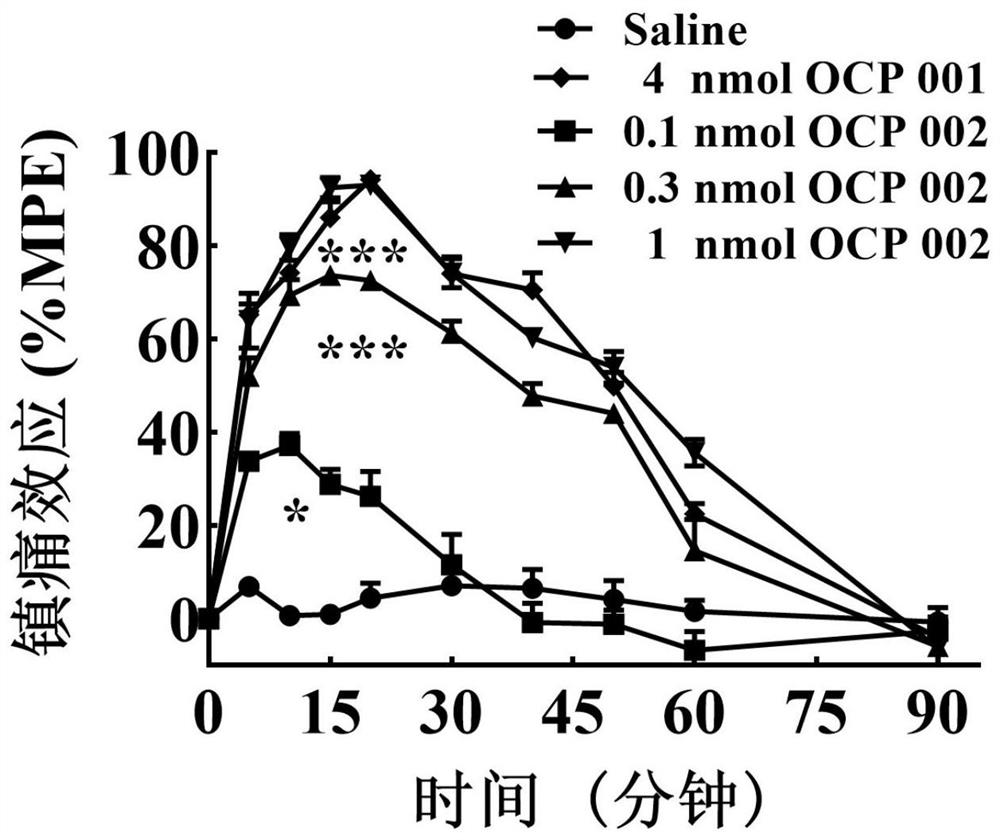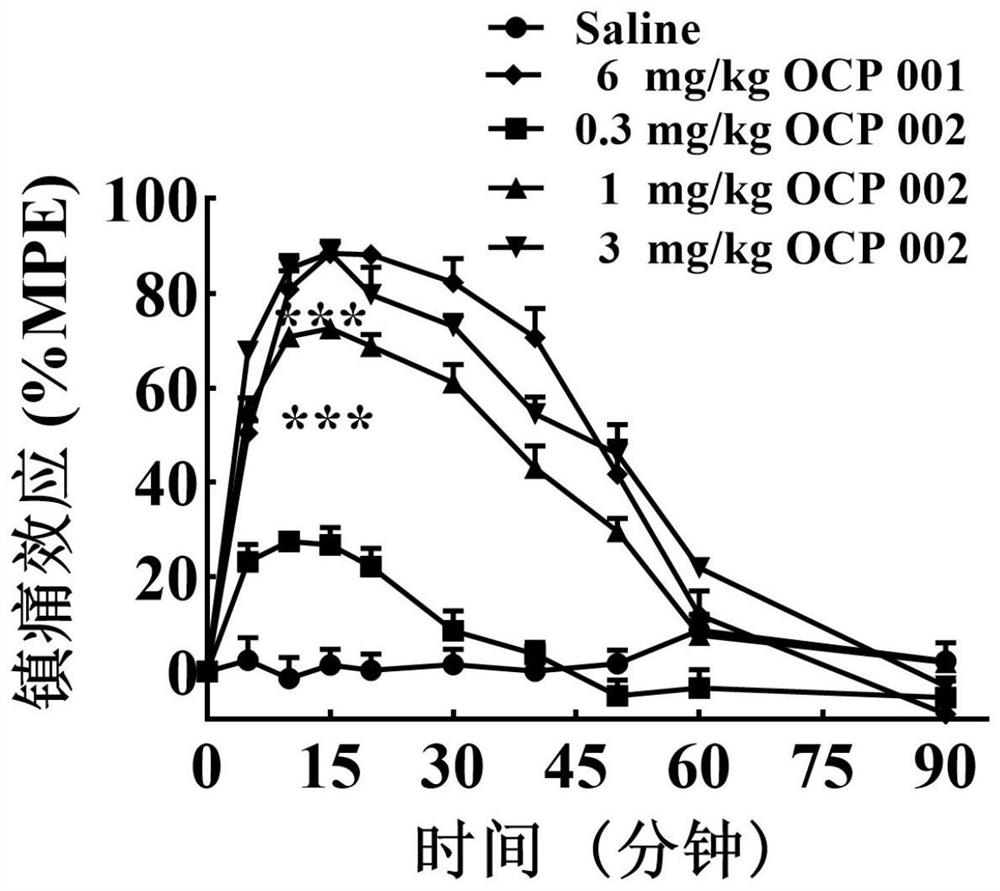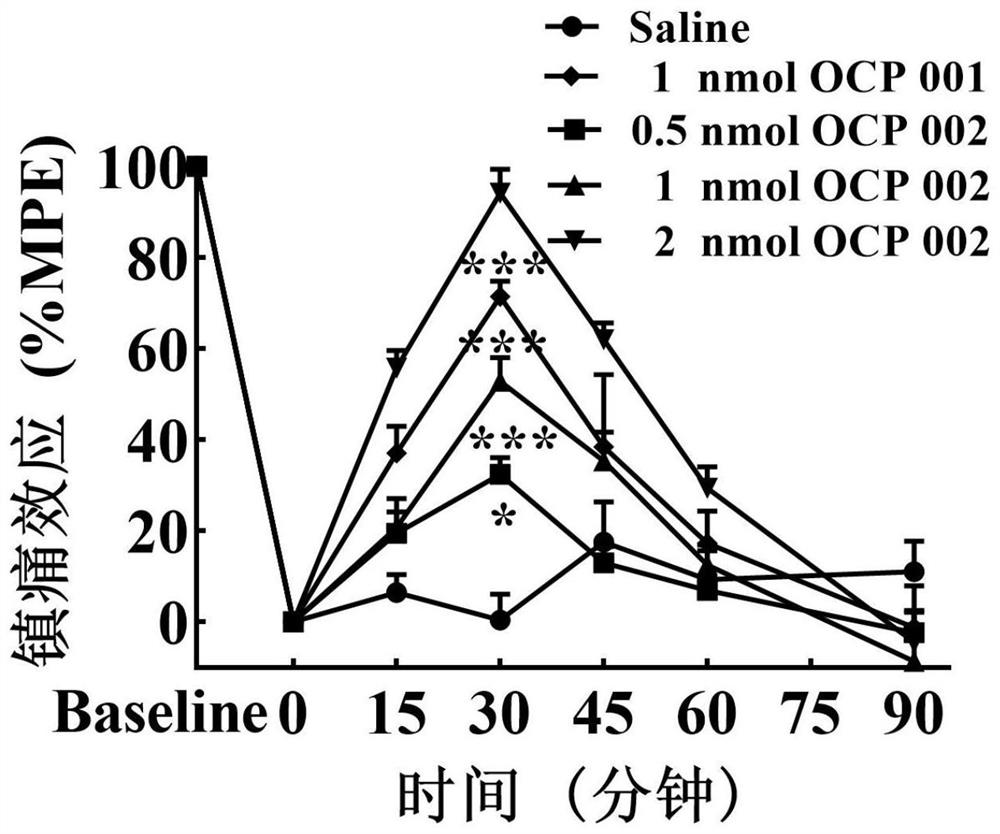Bifunctional peptide based on opioid peptide and cannabis sativa peptide as well as preparation method and application thereof
A bifunctional peptide and cannabinoid technology, applied in the field of biochemistry, can solve the problems of limited application scope, large differences in absorption and metabolism properties, complex pharmacokinetic properties, etc., to achieve enhanced analgesic activity and effective analgesic effect. Effect
- Summary
- Abstract
- Description
- Claims
- Application Information
AI Technical Summary
Problems solved by technology
Method used
Image
Examples
Embodiment 1
[0062] The synthesis of embodiment 1OCP 001
[0063] (1) Resin pretreatment: Weigh 600 mg of Rink-Amide-MBHA resin, stir and swell in 6 mL of dichloromethane at 80 rpm, the reaction time is 30 min, and drain for 30 min after the reaction. Then add DMF to wash 3 times, each 3min.
[0064] (2) Removal of Fmoc group protection: Add a mixed solution of piperidine with a volume fraction ratio of 1:1:98: DBU:DMF to the swollen resin, and the volume-to-mass ratio of the mixed solution to the swollen resin is 10 mL / g; according to 80rpm stirring 5min, repeat 2 times. After draining, the above mixed solution was added again, and stirred at 80 rpm for 10 min. After that, it was washed 4 times with DMF, each time for 3 min, to remove residual piperidine. Resin from which Fmoc protecting group has been removed is obtained.
[0065] (3) Indene detection: pick a small amount of resin into a colorless transparent glass tube, add indene detection reagent, and place it in boiling water fo...
Embodiment 2
[0070] The synthesis of embodiment 2OCP 002
[0071] (1) Resin pretreatment: Weigh 600 mg of Rink-Amide-MBHA resin, stir and swell in 6 mL of dichloromethane at 80 rpm, the reaction time is 30 min, and drain for 30 min after the reaction. Then add DMF to wash 3 times, each 3min.
[0072] (2) Removal of Fmoc group protection: Add a mixed solution of piperidine with a volume fraction ratio of 1:1:98: DBU:DMF to the swollen resin, and the volume-to-mass ratio of the mixed solution to the swollen resin is 10 mL / g; according to 80rpm stirring 5min, repeat 2 times. After draining, the above mixed solution was added again, and stirred at 80 rpm for 10 min. After that, it was washed 4 times with DMF, each time for 3 min, to remove residual piperidine. Resin from which Fmoc protecting group has been removed is obtained.
[0073] (3) Indene detection: pick a small amount of resin into a colorless transparent glass tube, add indene detection reagent, and place it in boiling water fo...
Embodiment 3
[0082] Example 3: Based on opiate peptide DALDA and cannabinoid peptide (m)VD-Hpα-NH 2 Analgesic experiments of bifunctional peptides
[0083] The present invention is based on the opioid peptide DALDA and the cannabinoid peptide (m) VD-Hpα-NH 2 A bifunctional peptide based on the opioid peptide DALDA and the cannabinoid peptide (m)VD-Hpα-NH 2 The newly constructed bifunctional peptide effectively reduces the side effects of analgesic tolerance while exerting high-efficiency analgesic effects. The analgesic and tolerance effects of the bifunctional peptides OCP 001 and OCP002 of the present invention will be described below through pharmacological experiments.
[0084] 1. Analgesic experiment
[0085] The compounds OCP 001 and OCP 002 prepared in Example 1 and Example 2 were injected into the ventricle of the brain and subcutaneously, respectively, to regulate pain in vivo in the models of acute pain induced by light and heat and inflammatory pain induced by carrageenan Ac...
PUM
 Login to View More
Login to View More Abstract
Description
Claims
Application Information
 Login to View More
Login to View More - R&D
- Intellectual Property
- Life Sciences
- Materials
- Tech Scout
- Unparalleled Data Quality
- Higher Quality Content
- 60% Fewer Hallucinations
Browse by: Latest US Patents, China's latest patents, Technical Efficacy Thesaurus, Application Domain, Technology Topic, Popular Technical Reports.
© 2025 PatSnap. All rights reserved.Legal|Privacy policy|Modern Slavery Act Transparency Statement|Sitemap|About US| Contact US: help@patsnap.com



